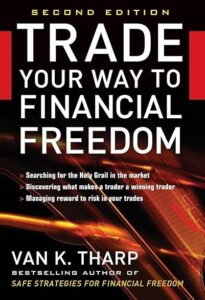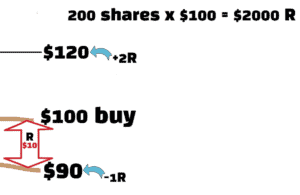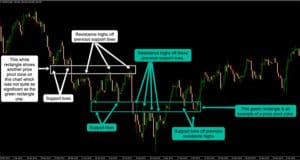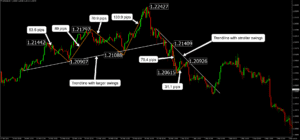Ever wondered what the secret of trading success is?
Dr. Tharp suggests it can be discovered very fast however it’s different for each of us.
Prepare to level up your trading skills as we’ll uncover three key ideas from Dr Van Tharp’s masterpiece book, Trade Your Way to Financial Freedom.
Dr. Van Tharp began teaching traders in 1982, and since then he’s coached over 5000 traders. He’s a well-known financial psychologist, founder of the Van Tharp Institute, and author of five top-rated books, including two top-rated best sellers.
Van Tharp covers major trading topics by dividing his techniques into six parts: reliability, risk: reward ratio, account size, trading options, trading costs, and money management. When developing a trading strategy, you must consider these six factors.
Many think successful trading is mainly down to entry techniques, but Dr Van Tharp disagrees. He states that a good trading strategy is only 10% down to entries. So, the next time someone tries selling you their incredible entry system that makes 200% a year, be sure to run away fast.
Van Tharp mentions other significant factors to consider are personal risk tolerance, sensible money management, and an exit plan. From his vast experience, he discovered an interesting fact: successful traders do great with risk control and protect themselves against significant losses.
1 – Understanding your requirements
He mentions that trading strategies start with a self-review to evaluate your strengths and weaknesses. Do you deal with drawdowns well? What are your profit expectations? What timeframes best suit your lifestyle? We can begin to create a personal profile by answering these types of questions and looking at an individual’s goals. From working out the foundation of your personal trading profile, you can adjust a trading strategy around it. I’ll share examples to help you understand what Van Tharp means by people having different profiles.

Newbie Nick: Our young hero is still in high school and has a small trading account. Though he may face limitations, Nick can apply higher-risk position sizing, knowing that the lessons learned at a younger age will overcome any temporary losses.
Businessman Brian: As an investment fund manager, Brian manages a substantial amount of clients’ money. While he’s not too concerned about trading costs, he must keep account drawdowns as low as possible to retain his clients’ trust.
As you can see, everyone will have to tailor their trading strategy to their needs depending on various factors. Also, be aware that you should dive deeper into asking yourself other questions to develop a greater profile.
2 – Expected Returns
Let’s go on to understand an essential part of successful trading—the notion of R, as Van Tharp puts it. Hang on a sec, I didn’t sign up for algebra class says Newbie Nick. Hold your horses Nick; R simply refers to risk, it’s not algebra.
By setting a stop-loss you’ll know how much you’re risking on a trade. But it’s key to understand R to use position sizing tactics effectively. R represents the price you want to exit a trade to help maintain your account. It’s the level that you realize the risk-to-reward would no longer be profitable, and you’d preferably exit a trade position.
Here’s an example to help you calculate R. If we purchase a stock for $100 and want to exit if price decreases to $90 or less, then the R amount for the setup is $10. If we buy 200 shares, the total risk is simply $2000, which is the 1R amount.
If we bought that company for $100 with a stop loss of $90 and closed the trade at $90, we’d have a minus 1R result. We lost $10, which is the R value. However, if the share price increased and our trade closed at $120, then our result is plus 2R as we made double what we risked.
Our losses should ideally have an R total from zero to minus 1.
It’s vital to be aware that a loss can potentially be greater than minus 1R if we have high costs from commissions and slippage. Also, a stock can gap against us and go through our exit price, resulting in a loss being greater than 1R.

To help avoid gapping and slippage, you should be aware of major news releases because gaps often occur during these times. A quick tip is to always check the economic calendar and filter for major news releases so you know when not to be in a trade with a tight stop.
Let’s move on to talk about the art of exiting trades. The book mentions various exit techniques which can help optimize profits and minimize losses. The first technique is called a time-based exit, which means that if a trade hasn’t reached the profit target within a time frame, it will be closed.
The major benefit of this type of exit is that it helps traders avoid getting stuck in stagnant positions and allows them to reallocate their capital to potentially more profitable opportunities. Most traders use a time-based exit along with another one of the exit techniques, which I’ll explain next.
Profit target exits
This technique is when traders set a specific price target to exit the trade. If price hits the target they exit and take profit. Having profit targets can help avoid the temptation of greed by making sure a trader doesn’t hold onto a winning trade for too long. Another benefit of this technique is that you can set it and not be concerned about managing the position overnight as you might have to do with a trailing stop loss exit technique.
Trailing Stop Exit
A trailing stop exit is a dynamic strategy that allows traders to ride a trend while protecting their profits. As a trade moves more in profit, one can adjust the stop-loss to trail behind price to lock in a profit. A major benefit of the trailing stop is that it helps catch larger gains in trending markets while reducing the risk of giving back profit. The disadvantage of this exit is that in a more range-bound market environment, price is more likely to reverse quicker leaving no chance to lock in profit.
Each exit technique Van Tharp mentions allows traders to adapt to market conditions and manage risk accordingly. By utilizing the right exit strategy for the right opportunity, traders can protect their capital, increase profits, and develop discipline with their trading plan.
3 – Psychology and money management
Van Tharp states that successful trading primarily involves managing emotions and maintaining risk control through money management techniques. Position sizing is vital to money management, as it helps limit the risk for any trade position.
A popular position sizing technique is to risk 1% of your account on each trade. However, it’s essential to be aware that for strategies with a low win rate and high frequency of trades, even 1% can be too risky. So instead of adopting advice from others, changing the amount you risk based on your strategy and risk tolerance is helpful, according to the book.
The book mentions important trading characteristics such as self-awareness, patience, and discipline.
Understanding Van Tharp’s principles from the book will help improve trading skills and potentially lead to financial freedom.
If you found value from reading this make sure you check out more content like this from the blog page.






